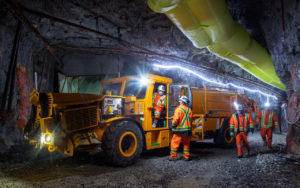Below the surface a quiet revolution is taking place as Canadian mines move towards adoption of battery electric vehicles. A properly trained workforce is essential to the successful adoption of these new technologies, explains MacLean Engineering’s Stuart Lister

A MacLean battery electric TM3, a mobile concrete mixer, underground at the company’s Research and Training Facility in Greater Sudbury, Ontario.
Photo courtesy of MacLean. Photography credit: James Hodgins, Mining Industrial Photographer
Below the surface a quiet revolution is taking place as Canadian mines move towards adoption of battery electric vehicles. A properly trained workforce is essential to the successful adoption of these new technologies, explains MacLean Engineering’s Stuart Lister

This article is Sponsor Content presented by MacLean Engineering.
I am lucky to have been one of the early visitors to Canada’s first all-electric mine: Newmont’s Borden Gold project near Chapleau in northern Ontario. Back in 2016, MacLean sold a fleet of battery electric support vehicles to the then-mine owner, Goldcorp, and both parties helped to make Canadian history with an industry “first.”
Since then I’ve visited the site a number of times — including one memorable trip for a video shoot where the mine manager agreed to appear on-camera to provide a frontline perspective on what electrification of mining means (Thank you, Luc).
The line that grabbed my attention, and stays with me to this day, was that Goldcorp had designed and built the mine to be “silent, invisible, and green.”
Silent and invisible in terms of not being heard or seen by the surrounding cottagers on the pristine Borden Lake, and green in terms of the diesel-free fleet, which now includes 15 MacLean production support units.
The mining industry is moving past the diesel vs. electric vehicle debate…to the actual EV project planning and implementation phase.
Witnessing a paradigm shift
Fast forward several years from that conversation and, thanks in large part to Goldcorp taking that important first step in an industry where fast following (rather than leading) is the norm, Canada now occupies a global leadership position in the battery electrification of underground mining. This has allowed MacLean and other electric equipment manufacturers to gain a frontline perspective on a paradigm change in the industry.
An important signal last year was a federal government policy announcement on the greening of Canadian mining by Prime Minister Justin Trudeau at the March 2020 Prospectors and Developers Association of Canada (PDAC) conference. Since then, despite COVID-19, the business drivers for green mining — improved health and safety, cleaner work environments, lower greenhouse gas (GHG) emissions, reduced ventilation energy costs — have only gained momentum. There is now a long list of major miners around the globe making public pledges about carbon reduction, with a number of them having set goals for carbon-neutral mining operations by the middle of the century.
Achieving this net neutral goal requires new technologies and new ways of doing — including moving from diesel combustion fleets to battery electric fleets. Now that high-density battery technology is proven in the underground mining application, industry attention has turned to skills development. You need a properly trained workforce to understand and adopt new technologies.
Building a newly trained workforce
This is where we are right now: the mining industry is moving past the diesel vs. electric vehicle debate and past the project-based case study phase to the actual EV project planning and implementation phase. But even though battery electric vehicles (BEVs) deliver a zero-emissions, low-noise, and low-vibration working environment, this doesn’t mean that their acceptance can be assumed as a given at any mine – not because the machine isn’t up to the job, but because you need the right workers to do the job.
The industry’s current focus on training is a good signpost that the electric transition is well underway. The work to support the greening of mining involves both the technical aspect of matching BEV units’ specific duty cycles to their battery cycles, as well as a mindset change for operators. Where historically you could fuel up a mining vehicle like a boom truck once every two shifts, now you need to think about opportunity charging — regular top-ups of battery charge level during the shift, within the duty cycle.
The same goes for training heavy-duty mechanics to be able to repair the new generation of diesel-free mining vehicles at all-electric or transitioning mines. This is why MacLean recently partnered with Cambrian College to open up the MacLean Research and Training Facility (our test course in Sudbury) to the practical component of Cambrian’s course for heavy-duty mechanics looking to upskill on battery electric mining vehicle repair.
Let it be known: there is a revolution in mining underway underground; you just can’t see it, hear it, or smell it.
An important shift is happening – silent, invisible, green – and Canada is leading the way.

Stuart Lister is the Vice President of Marketing and Communications at MacLean Engineering, which specializes in underground mobile equipment solutions based on hard rock mining experience.






